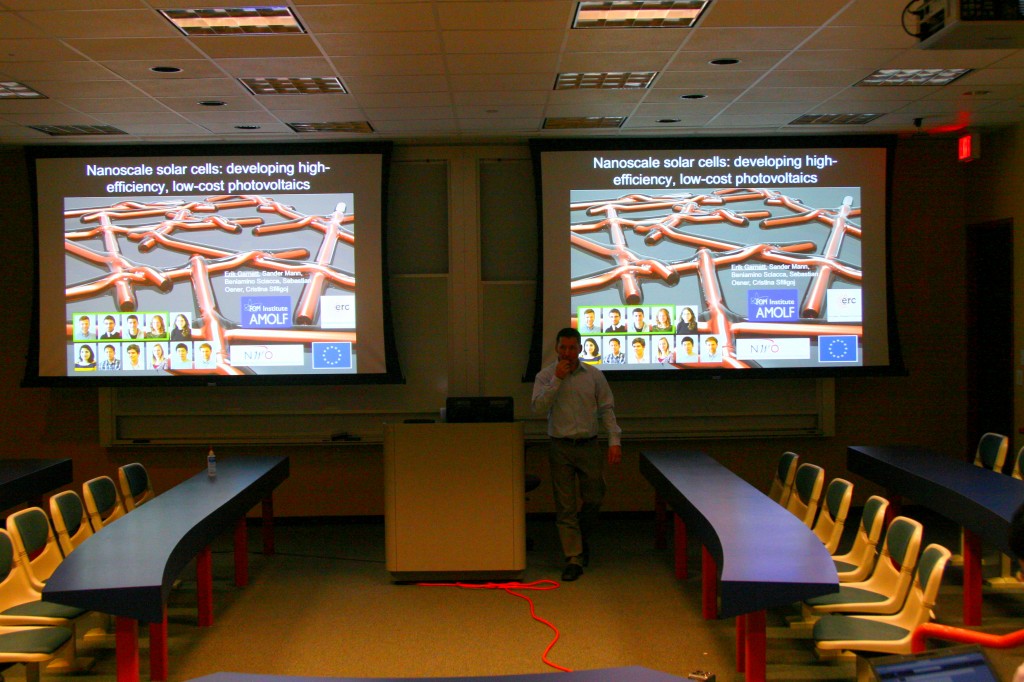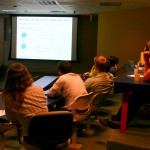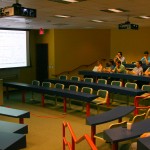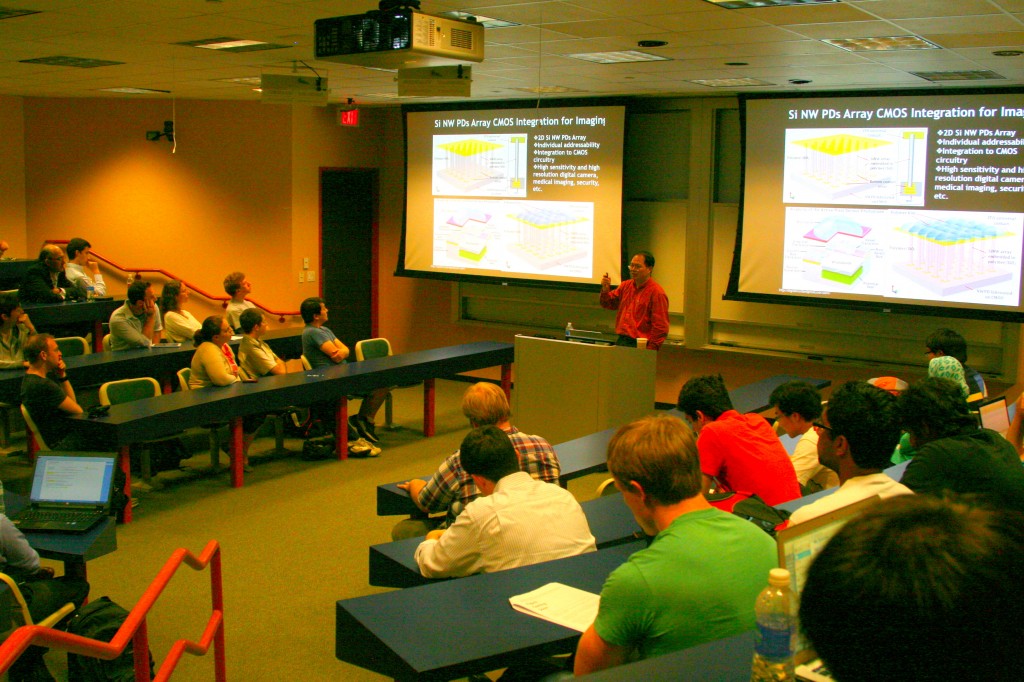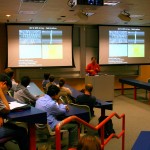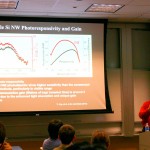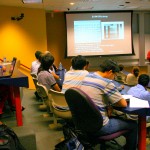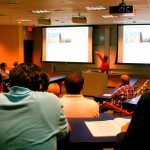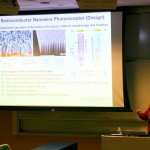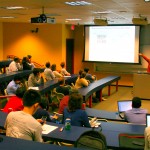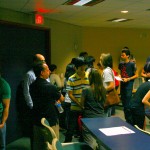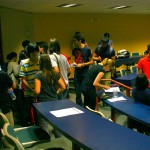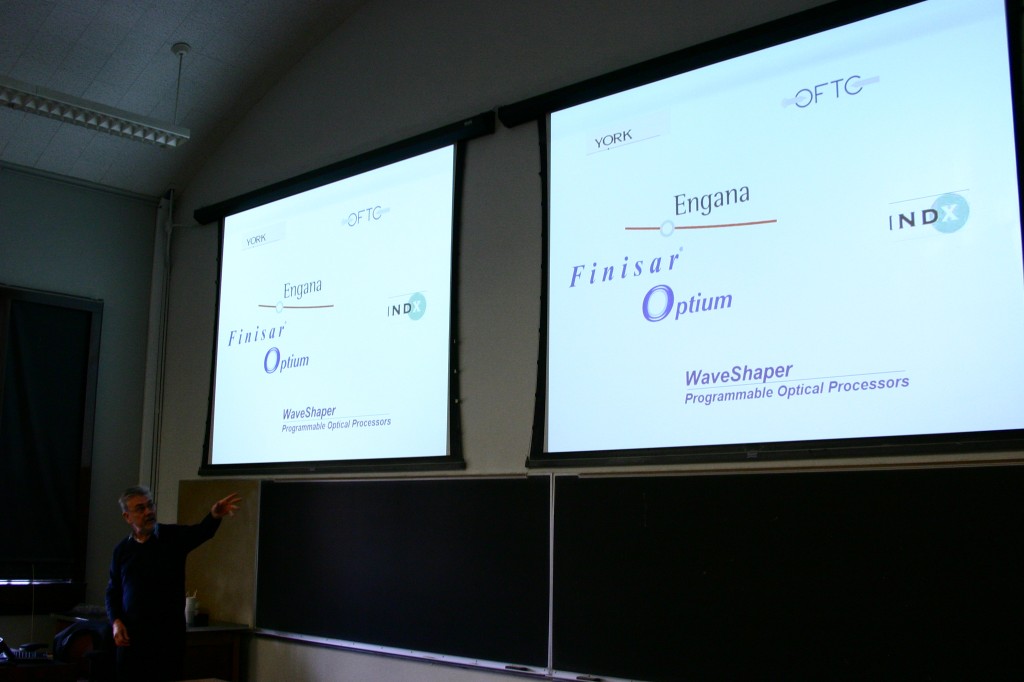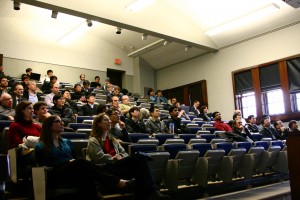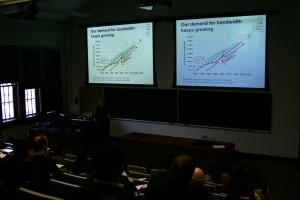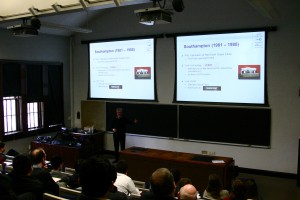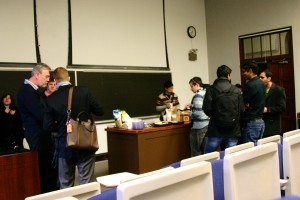IEEE Photonics Seminar Dr. Lionel Vayssieres
Date: November 14
Time: Noon
Location: Duncan Hall 1064
Aqueous Design, Electronic Structure & Applications of Quantum-confined Metal Oxides for Solar Energy Conversion
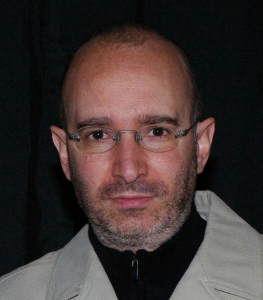 The demand of low cost functional and highly efficient materials has become a major challenge scientists face to answer crucial contemporary issues such as clean alternative energy sources and sensors for a safer and cleaner environment and for better health. For instance, one of the promising alternatives for the transition of energy resource from its fossil fuel-based beginning to a clean and renewable technology relies on the widespread implementation of solar-related energy systems, however the high cost of energy production and low-energy of currently used material combinations pose an intrinsic limitation. In this context, new materials development is required to achieve the necessary dramatic increases in power generation and conversion efficiency. The necessity of materials development which is not limited to materials that can achieve their theoretical limits, but makes it possible to raise these limits by changing the fundamental underlying physics and chemistry is crucial. Low cost purpose-built, functional materials with optimized geometry, orientation, and aspect ratio combined with inexpensive large scale manufacturing methods will play a decisive role in the success of materials for renewable energy. However, fabricating and manufacturing large area of such functional materials is a daunting challenge. Novel smarter and cheaper fabrication techniques and, just as important, better fundamental knowledge and comprehensive understanding of materials and their syntheses as well as their properties using nanoscale phenomena such as quantum confinements to create multi-functional structures and devices is the key to success. R&D exploiting Nanoscience and Nanotechnology has the greatest potential to reach such challenging goals. Such ideas will be demonstrated by the thermodynamic modeling, low-cost aqueous design and fabrication of highly oriented crystalline arrays of metal oxide quantum dots and rods-based structures and devices with controlled orientation, size and shape onto various substrates designed at multiple scales by aqueous chemical growth at low-temperature along with the in-depth study of their electronic structure and quantum confinement effects performed at synchrotron radiation facilities and their applications for solar hydrogen generation and photovoltaics.
The demand of low cost functional and highly efficient materials has become a major challenge scientists face to answer crucial contemporary issues such as clean alternative energy sources and sensors for a safer and cleaner environment and for better health. For instance, one of the promising alternatives for the transition of energy resource from its fossil fuel-based beginning to a clean and renewable technology relies on the widespread implementation of solar-related energy systems, however the high cost of energy production and low-energy of currently used material combinations pose an intrinsic limitation. In this context, new materials development is required to achieve the necessary dramatic increases in power generation and conversion efficiency. The necessity of materials development which is not limited to materials that can achieve their theoretical limits, but makes it possible to raise these limits by changing the fundamental underlying physics and chemistry is crucial. Low cost purpose-built, functional materials with optimized geometry, orientation, and aspect ratio combined with inexpensive large scale manufacturing methods will play a decisive role in the success of materials for renewable energy. However, fabricating and manufacturing large area of such functional materials is a daunting challenge. Novel smarter and cheaper fabrication techniques and, just as important, better fundamental knowledge and comprehensive understanding of materials and their syntheses as well as their properties using nanoscale phenomena such as quantum confinements to create multi-functional structures and devices is the key to success. R&D exploiting Nanoscience and Nanotechnology has the greatest potential to reach such challenging goals. Such ideas will be demonstrated by the thermodynamic modeling, low-cost aqueous design and fabrication of highly oriented crystalline arrays of metal oxide quantum dots and rods-based structures and devices with controlled orientation, size and shape onto various substrates designed at multiple scales by aqueous chemical growth at low-temperature along with the in-depth study of their electronic structure and quantum confinement effects performed at synchrotron radiation facilities and their applications for solar hydrogen generation and photovoltaics.
Bio: Born in 1968, he obtained his high school diploma in Mathematics and Life Sciences in 1986 in the Academy of Grenoble. He then moved to Paris and studied at the Université Pierre et Marie Curie where he received a BSc. and a MSc in Chemical Physics and a postgraduate diploma in Inorganic Chemistry in 1989, 1990, and 1991 respectively as well as a PhD in Chemistry in 1995 for his research work on the Interfacial & thermodynamic growth control of metal oxide nanoparticles in aqueous solutions. Thereafter, he joined Uppsala University, Sweden as a postdoctoral researcher for the Swedish Materials Consortium on Clusters and Ultrafine Particles to extend his concepts and develop purpose-built metal oxide nanomaterials as well as to characterize their electronic structure by x-ray spectroscopies at synchrotron radiation facilities. He has been carried out his research work as a visiting scientist at: the University of Texas at Austin; the UNESCO Centre for Macromolecules & Materials, Stellenbosch University, and iThemba LABS, South Africa; the Glenn T. Seaborg Center, Chemical Sciences Division, at Lawrence Berkeley National Laboratory; Texas Materials Institute; The Ecole Polytechnique Fédérale de Lausanne, Switzerland; the University of Queensland, Australia, and Nanyang Technological University, Singapore. He has also been an independent scientist at the National Institute for Materials Science, Tsukuba, Japan for 8 years. He has (co-)authored 115 publications (75 SCI) in major international journals and book series which have already generated over 9650+ citations since the year 2000 (5100+ since 2011, Google Scholar); Top 1% scientist in Materials Science. All time 8 ISI highly cited papers (5 as first author). He has been interviewed by In-Cites and by ScienceWatch (Thomson Reuters) in 2006 for a single author original research paper cited now over 2550+ times and again in 2010 for another of his highly cited paper in Chemistry. Two other first-and-corresponding author 2001 papers have already been cited over 1000+ times and 10 others over 200 times. He has given over 345 lectures: 168 talks at international conferences (45 plenary, 100 invited, 21 contributed, 2 tutorials) and 177 seminars at universities, governmental and industrial research institutes in 30 countries and acted as an organizer, chairman, executive program committee and advisory member for major international conferences (MRS, ACS, SPIE, IUPAC, ACerS, IEEE). He is currently a full time 1000-talent scholar Professor at Xi’an Jiaotong University, P.R. China and the co-founder and co-director of the International Research Center for Renewable Energy (254 publications and 4700 citations since 2011) funded by the National Science Foundation of China. He is also, since 2003, the founding editor-in-chief of the International Journal of Nanotechnology, a referee for 80 SCI journals as well as major funding agencies in North and South America, Europe, Asia, and Africa and a guest scientist at Lawrence Berkeley National Laboratory, Chemical Sciences Division.
IEEE Photonics Seminar Dr. Tim Lian
Date: October 14
Time: Noon
Location: Dell Butcher Hall 180
Efficient Light-driven Long Distance Charge Separation and H2 Generation in Semiconductor Quantum Rod Hetertstructures
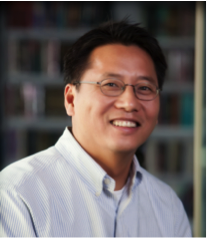 Quantum confined semiconductor nanocrystals (0D quantum dots, 1D quantum rods and 2D quantum platelets) have been intensively investigated as light harvesting and charge separation materials for photovoltaic and photocatalytic applications. The efficiency of these semiconductor nanocrystal-based devices depends on many fundamental processes, including light harvesting, carrier relaxation, exciton localization and transport, charge separation and charge recombination. The competition between these processes determines the overall solar energy conversion (solar to electricity or fuel) efficiency. Quantum confined semiconductor nano-heterostructures, combining two or more material components, offer unique opportunities to control their charge separation properties by tailoring their compositions, dimensions and spatial arrangement. Further integration of catalysts (heterogeneous or homogeneous) to these materials form multifunctional nano-heterostructures. Using 0D, 1D and 2D CdSe/CdS/Pt heterostructures as model systems, we directly probe the above-mentioned fundamental exciton and carrier processes by transient absorption and time-resolved fluorescence spectroscopy. We are examining how to control these fundamental processes through the design of heterostructures to achieve long-lived charge separation and efficient H2 generation. In this talk, we will discuss a new model for exciton dissociation by charge transfer in quantum dots (i.e. Auger assisted electron transfer), mechanism of 1D exciton transport and dissociation in nanorods, and key factors limiting H2 generation efficiency in CdSe/CdS/Pt nanorod heterostructures. (ref. Nano let. (2014) 14 , 1263-1269; JACS (2014), 136, 7708-7716; Accounts of chemical research (2015) 48, 851-859; Ann. Rev. Phys. Chem., (2016), 67, 259; Chem. Soc. Rev. (2016), 45, 3781)
Quantum confined semiconductor nanocrystals (0D quantum dots, 1D quantum rods and 2D quantum platelets) have been intensively investigated as light harvesting and charge separation materials for photovoltaic and photocatalytic applications. The efficiency of these semiconductor nanocrystal-based devices depends on many fundamental processes, including light harvesting, carrier relaxation, exciton localization and transport, charge separation and charge recombination. The competition between these processes determines the overall solar energy conversion (solar to electricity or fuel) efficiency. Quantum confined semiconductor nano-heterostructures, combining two or more material components, offer unique opportunities to control their charge separation properties by tailoring their compositions, dimensions and spatial arrangement. Further integration of catalysts (heterogeneous or homogeneous) to these materials form multifunctional nano-heterostructures. Using 0D, 1D and 2D CdSe/CdS/Pt heterostructures as model systems, we directly probe the above-mentioned fundamental exciton and carrier processes by transient absorption and time-resolved fluorescence spectroscopy. We are examining how to control these fundamental processes through the design of heterostructures to achieve long-lived charge separation and efficient H2 generation. In this talk, we will discuss a new model for exciton dissociation by charge transfer in quantum dots (i.e. Auger assisted electron transfer), mechanism of 1D exciton transport and dissociation in nanorods, and key factors limiting H2 generation efficiency in CdSe/CdS/Pt nanorod heterostructures. (ref. Nano let. (2014) 14 , 1263-1269; JACS (2014), 136, 7708-7716; Accounts of chemical research (2015) 48, 851-859; Ann. Rev. Phys. Chem., (2016), 67, 259; Chem. Soc. Rev. (2016), 45, 3781)
Bio: Tianquan (Tim) Lian received PhD degree from University of Pennsylvania (under the supervision of late Prof. Robin Hochstrasser) in 1993. After postdoctoral training with Prof. Charles B. Harris in the University of California at Berkeley, Tim Lian joined the faculty of chemistry department at Emory University in 1996. He was promoted to Associate Professor in 2002, Full Professor in 2005, Winship Distinguished Research Professor in 2007, and William Henry Emerson Professor of Chemistry in 2008. Tim Lian is the Co-Editor-In-Chief of Chemical Physics (since 2012), a Kavli fellow (since 2012), APS fellow (since 2015) and recipient of the NSF CAREER award and Alfred P. Sloan fellowship. Tim Lian research interest is focused on ultrafast energy and charge transfer dynamics in photovoltaic and photocatalytic nanomaterials and at their interfaces.
IEEE Photonics Seminar Dr. Hoe Tan
Date: October 7
Time: 4 PM
Location: Duncan Hall 1064
Semiconductor nano wires for optoelectronic and energy applications
Dr. Hoe Tan
Department Head of Electronic Materials Engineering
Research School of Physics and Engineering, The Australian National University
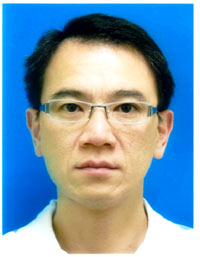 Abstract: The excitement of nanowire research is due to the unique electronic and optical properties of these nanostructures. Both axial and radial heterostructure nanowires have been proposed as nano-building blocks for the next generation devices, which are expected to revolutionise our technological world. The unique properties stem from their large surface area-to-volume ratio, very high aspect ratio, and carrier and photon confinement in two dimensions. These nanowires are usually grown by the so-called vapor-liquid-solid mechanism, which relies on a metal nanoparticle to catalyze and seed the growth. An alternative technique to grow the nanowires is by selective area growth technique, where a dielectric mask is first patterned on the substrate prior to growth.
Abstract: The excitement of nanowire research is due to the unique electronic and optical properties of these nanostructures. Both axial and radial heterostructure nanowires have been proposed as nano-building blocks for the next generation devices, which are expected to revolutionise our technological world. The unique properties stem from their large surface area-to-volume ratio, very high aspect ratio, and carrier and photon confinement in two dimensions. These nanowires are usually grown by the so-called vapor-liquid-solid mechanism, which relies on a metal nanoparticle to catalyze and seed the growth. An alternative technique to grow the nanowires is by selective area growth technique, where a dielectric mask is first patterned on the substrate prior to growth.
In this talk, I will present an overview of compound semiconductor nanowire research activities at The Australian National University. The optical and structural properties of binary and ternary III-V nanowires including GaAs, InGaAs, InP and GaAsSb nanowires grown by metal-organic vapour phase epitaxy will be presented. Various issues such as tapering of the nanowires, compositional non-uniformity along nanowires, crystal structure, carrier lifetime and polarization effect will be discussed. I will also present our results of III-V nanowires grown on Si substrates which are of great interests for the integration of nano-optoelectronic devices on Si platforms. Our results of enhancing the quantum efficiency of nanowires by using plasmonics are promising to improve the performance of nanowire devices. Finally, the results from our nanowire lasers, photodetectors, solar cells and photoelectrodes for water splitting will be presented.
Bio:
Prof. Tan is currently the Head of the Department of Electronic Materials Engineering at the Research School of Physics and Engineering, The Australian National University. He received his B.E. (Hons) in Electrical Engineering from the University of Melbourne in 1992, after which he worked with Osram in Malaysia as a quality assurance engineer. In 1997, he was awarded the PhD degree from the Australian National University for his dissertation on “Ion beam effects in GaAs-AlGaAs materials and devices”. He has been the past recipient of the Australian Research Council Postdoctoral, QEII and Future Fellowships. He has published/co-published over 350 journal papers, including four book chapters. He is also a co-inventor in 4 US patents related to laser diodes and infrared photodetectors. His research interests include epitaxial growth of low-dimensional compound semiconductors, nanostructured optoelectronic devices and ion-implantation processing of compound semiconductors for optoelectronic device applications. Prof. Tan is a Senior Member of the IEEE.
IEEE Photonics Houston welcomes Dr. Ke Sun
Date: May 26th
Time: 4 PM
Location: Duncan Hall 1064
Photon, Electron, and Ion Management in Artificial Photosynthesis: Realizing Efficient Renewable Energy to Fuel Conversion
Postdoc fellow in the Division of Chemistry and Chemical Engineering
California Institute of Technology
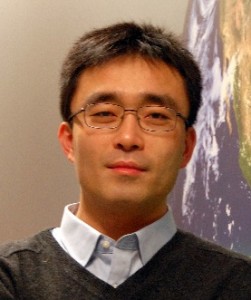
Abstract: Direct production of fuels from sunlight, air (N2 or CO2), and water that can be stored, transported, and later converted into hydrogen or electricity to provide power for transportation and distributed energy generation, have received recent attentions worldwide. This technology could also provide chemicals as synthetic precursors or realize grid-level storage of intermittent solar energy. In artificial photosynthesis based on semiconductor photoelectrochemistry, production of chemical fuels generally requires coupling of the separated electrical charges with catalysts for multi-electron chemical reactions. Meanwhile, the development of integrated, efficient and stable photoelectrochemical (PEC) systems requires the pairing of efficient and stable light-absorbing materials with an optimum band-gap combinations. The development of such systems, using water-splitting as an example, has been hindered in part by the lack of semiconducting materials that can simultaneously provide efficiency and stability in corrosive environment, typically as strong acid or base. In this talk, I will present our recent progress in the development of efficient and stable PEC devices for H2 production from solar-driven water splitting. First, I will summarize some recent development of photon management in PEC devices and future module designs from modeling to experiment. Then, I will discuss methods for heterogeneous interfacial energetic modification on covalence-bond semiconductors for efficient free carriers (electrons/holes) separation. Finally, I will present a novel approach in managing ionic environment to create a defect-tolerant condition, which leads to a demonstration of a record-setting solar water-splitting prototype.
Bio: Dr. Ke Sun is currently a senior postdoctoral fellow advised by Professor Nathan S. Lewis in the Division of Chemistry and Chemical Engineering and in the Joint Center for Artificial Photosynthesis (JCAP) at Caltech. He holds his B.Sc, M.Sc and Ph.D degrees from the Beijing Institute of Technology, University of South Florida, and University of California, San Diego in 2003, 2009 and 2013, respectively. As a graduate student, his research was focused on hierarchically-structured nanomaterials from synthesis, characterization to applications in biosensors, optoelectronics, and photoelectrochemical devices. His current research effort is centered on the understanding of the corrosion mechanisms and developing defect-tolerant materials, structures and environment for integrated solar-fuel conversion devices. Dr. Sun has established an outstanding publication record having published in top-ranked journals and having been widely cited for his contribution to the protection of photoelectrodes and general semiconductor photoelectrochemistry. His future research interests are materials innovation and electrochemistry for water, energy and electronics, specifically 1) synthesis, integration and assembly of 2D materials for electrochemical energy conversion, storage and usage; 2) materials synthesis and characterization for electrochemical water treatment, chemical detection and seawater desalination driven by renewable energy; 3) electronic devices, photonics, electrochromic display, and photoelectrochemical biosensors.
IEEE Photonics Houston welcomes Dr. Jeremy N. Munday
Date: Monday, May 16th
Time: 4:00 PM
Location: Herzstein 210
The Physics and Photonics of Next Generation Solar Cells
Jeremy N. Munday
Electrical and Computer Engineering, and
The Institute for Research in Electronics and Applied Physics
University of Maryland, College Park, MD
Email: jnmunday@umd.edu, web site: mundaylab.umd.edu
Converting sunlight into electricity is an important process that spans many fields from physics and chemistry to electrical engineering and materials science. For a traditional solar cell, the maximum power conversion efficiency is ~33%; however, the thermodynamic limit for converting sunlight to power is ~95%. So what happens to this extra 62% and can it be recovered? Surprisingly, optics may hold the key to recovering much of this loss. Here, I will present our recent work on a variety of architectures used to confine and control light on the nanoscale for applications in solar energy. Structures can be designed to act as broadband antireflection coatings, localized couplers to waveguide modes, and optical concentrators. To surpass the efficiency limit of traditional photovoltaic devices, I will discuss novel new methods using nanoscale optical concentration, photonic crystals to effectively modify the semiconductor bandgap, and the generation and collection of hot electrons in plasmonic structures.
Bio: Dr. Jeremy N. Munday is an Assistant Professor in the Department of Electrical and Computer Engineering at the University of Maryland, College Park. He received his PhD in Physics from Harvard University in 2008 and was a postdoctoral scholar at Caltech prior to his appointment at Maryland. His research themes range from quantum electromechanical phenomena (such as the Casimir effect) to fundamental solar energy conversion processes with an emphasis on the optics, photonics, and thermodynamics of such systems. He and his group strive to demonstrate new technologies based on fundamental physics and energy conversion processes. He is a recipient of the NSF CAREER Award, ONR YIP Award, the OSA Adolph Lomb Medal, the IEEE Photonics Society Young Investigator Award, the SPIE Early Career Achievement Award, and the NASA Early Career Faculty Space Technology Research Award.
IEEE Photonics Houston welcomes Prof. Jacob Kurgin
Date: Friday April 15th, 2016
Time: 12:00 PM
Location: Herzstein 210
Disorder Engineering: Putting Disarray into Productive Use in Optics and Electronics
Abstract:
In theoretical physics the behavior of disordered systems belongs to a challenging, if somewhat esoteric, domain, where great science is being done with not too much interest in practical applications In contrast to this, in the practical mind of an engineer, disorder is nothing but an unwelcome nuisance to be avoided at any cost. In my presentation I will attempt to show that the middle ground does exist and there is a surprisingly wide niche of everyday applications where disorder can play a constructive role and improve performance of the devices or even serve as an operating principle of some of them. I will briefly describe how disorder, when properly applied, is in fact beneficial to a variety of seemingly unrelated devices – high mobility field effect transistors, Schottky-barrier optical detectors, plasmonic Raman and fluorescent sensors, and mid-infrared quantum cascade lasers. In all of these cases deliberate introduction of disorder has led to remarkable improvement of the devices’ performance.
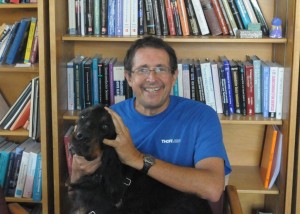
Jacob B. Khurgin has been a Professor of Electrical and Computer Engineering at Johns Hopkins University from 1988. Prior to that he was a Senior Member of Research Staff at Philips NV where he developed various appliances, display components and systems including 3-D projection TV and visible lasers pumped by electron beam. Prof. Khurgin’s main area of expertise is in optical and electronic solid state devices. In his 28 years at JHU Prof. Khurgin had made contributions in the fields of nonlinear optics, semiconductor optoelectronic devices, quantum-cascade lasers, optical communications, THz technology, microwave photonics, slow light, plasmonics, opto-mechanics, and fundamental condensed matter physics. Prof Khurgin had authored over 300 technical papers, 500 conference presentations, 5 book chapters, and 35 patents. He is a Fellow of American Physical Society and Optical Society of America. Prof. Khurgin holds a PhD from Polytechnic University of New York (now NYU School of Engineering).
IEEE Photonics Houston welcomes Prof. Edward Yu
Date: Thursday, November 19, 2015
Time: 4:00 p.m. – 5:00 p.m.
Location: Duncan Hall 1064
Event information
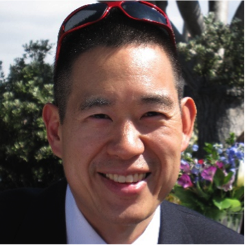 The science and engineering of materials and device structures at the nanometer scale have become central themes in fields ranging from solid-state electronics and photonics to the biological sciences. As a result, the characterization, understanding, and control of material and device properties at the nanometer to atomic scale have emerged as essential aspects of materials and device engineering. We will discuss some recent results from our laboratory in which metal, dielectric, and semiconductor nanostructures are exploited to achieve increased efficiency in solar energy harvesting, and to enable near-field Raman spectroscopy for solid-state nanostructure characterization. In the area of solar energy harvesting, we discuss approaches for improving power conversion efficiency in thin-film solar cells using light scattering by metal and dielectric nanostructures integrated with semiconductor absorbing layers, and for employing nanostructured catalysts combined with epitaxial complex oxides grown on silicon substrates for improved efficiency in solar-driven water reduction. In the area of nanoscale optical characterization, we will show how plasmonic localization of light in tip-enhanced Raman spectroscopy enables highly localized characterization of bonding, strain, and phonon-carrier interactions at the nanoscale in Ge/SiGe core/shell semiconductor nanowires. Time permitting, recent results on demonstration and analysis of highly controlled, room-temperature quantized conductance in single-crystal TiO2 resistive switching elements grown on silicon will also be discussed.
The science and engineering of materials and device structures at the nanometer scale have become central themes in fields ranging from solid-state electronics and photonics to the biological sciences. As a result, the characterization, understanding, and control of material and device properties at the nanometer to atomic scale have emerged as essential aspects of materials and device engineering. We will discuss some recent results from our laboratory in which metal, dielectric, and semiconductor nanostructures are exploited to achieve increased efficiency in solar energy harvesting, and to enable near-field Raman spectroscopy for solid-state nanostructure characterization. In the area of solar energy harvesting, we discuss approaches for improving power conversion efficiency in thin-film solar cells using light scattering by metal and dielectric nanostructures integrated with semiconductor absorbing layers, and for employing nanostructured catalysts combined with epitaxial complex oxides grown on silicon substrates for improved efficiency in solar-driven water reduction. In the area of nanoscale optical characterization, we will show how plasmonic localization of light in tip-enhanced Raman spectroscopy enables highly localized characterization of bonding, strain, and phonon-carrier interactions at the nanoscale in Ge/SiGe core/shell semiconductor nanowires. Time permitting, recent results on demonstration and analysis of highly controlled, room-temperature quantized conductance in single-crystal TiO2 resistive switching elements grown on silicon will also be discussed.
Biography of Edward Yu:
Edward Yu received his A.B. (summa cum laude) and A.M. degrees in Physics from Harvard University in 1986, and his Ph.D. degree in Applied Physics from the California Institute of Technology in 1991. In September 1992, following a one-year postdoctoral appointment at the IBM Thomas J. Watson Research Center in Yorktown Heights, NY, he joined the faculty of the University of California, San Diego as Assistant Professor of Electrical and Computer Engineering. He was promoted to Associate Professor in 1996 and Professor in 1998. In 2009 he joined the faculty of the University of Texas at Austin as Professor of Electrical and Computer Engineering, and Judson S. Swearingen Regents Chair in Engineering. Professor Yu has been the recipient of an NSF CAREER Award, ONR Young Investigator Award, Alfred P. Sloan Research Fellowship, and UCSD ECE Graduate Teaching Award, and is an AVS and IEEE Fellow. He has served on numerous conference organizing committees including General Chair and Program Chair of the TMS Electronic Materials Committee and Electronic Materials Conference, and Division Chair and Program Chair of the AVS Nanometer-Scale Science and Technology Division. He currently serves as a member and past Chair (2012-14) of the DARPA Defense Sciences Research Council (DSRC). Current research interests in his laboratory include photovoltaics and other technologies for energy harvesting and generation; nanoscale imaging and characterization techniques; device applications for epitaxial oxide materials; and solid-state nanoscience and nanotechnology generally. The results of his research have been reported in over 170 archival journal publications.
IEEE Welcomes Prof Gennady Shvets for 3 talks:
“Science and applications of infrared metamaterials: from thermo-photovoltaics to graphene-integrated plasmonic metasurfaces”
Date: Monday, March 16, 2015
Time: 3:00pm – 4:00pm
Location: Smalley-Curl Room, Space Science 301A
Wine & Cheese Reception after the talk
In this talk Prof Gennady Shvets will discuss novel directions in STPV that take advantage of plasmonic metamaterials. He will also discuss the prospects for turning metasurfaces into an actively-tunable platform for ultra-fast light manipulation. The rapid tunability is accomplished by integrating plasmonic metasurfaces with single-layer graphene.
“Fano-resonant plasmonic nanosensors”
Date: Tuesday, March 16, 2015
Time: 12noon – 1:15pm
Location: Smalley-Curl Room, Space Science 301A
Lunch will be served
This talk will cover two Fano-type plasmonic nanosensors. The first one uses Fano-resonant metasurfaces for detection and characterization of protein monolayers and live cells. The second one uses Fano interference between weakly-scattering objects (e.g., single quantum dots) and plasmonic nanoparticles.
(Lunch will be served – https://rcqm.webconnex.com/GennadyShvetsLunch – RSVP Required for this Talk)
“Photonic Topological Insulators: Guiding Electromagnetic Waves Around Sharp Corners”
Date: Tuesday, March 16, 2015
Time: 5:15 pm
Location: Space Science Room 337
Refreshments will be served beginning at 5:00 pm
Prof Gennady will provide an overview of the exciting field of PTIs, with particular emphasis on reciprocal photonic structures that do not rely on magnetic fields. He will also describe a simple photonic structure [6], a periodic array of metallic cylinders attached to one of the two confining metal plates shown in Fig.1(a), that behaves as a PTI: possesses a complete topological bandgap and emulates spin-orbit interactions. An interface between two such structures supports topologically protected surface waves which can be guided without reflections along sharp bends of the interface as shown in Fig.1(d). Perspectives on how photonic topological insulators can emulate condensed-matter phenomena will be presented.
More details about this talk – Click Here !!
A brief look at Dr. Gennady Shvets
Professor of Physics at The University of Texas at Austin
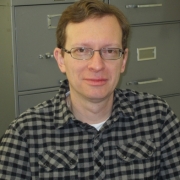 Gennady Shvets received his PhD in Physics from MIT in 1995. He has been on the Physics faculty at the University of Texas at Austin since 2004. Previously he has held research positions at the Princeton Plasma Physics Laboratory and the Fermi National Accelerator Laboratory, and was on the faculty of the Illinois Institute of Technology. His research interests include nanophotonics, optical and microwave metamaterials and their applications (including bio-sensing, optoelectronic devices, and vacuum electronics), and plasma physics.
Gennady Shvets received his PhD in Physics from MIT in 1995. He has been on the Physics faculty at the University of Texas at Austin since 2004. Previously he has held research positions at the Princeton Plasma Physics Laboratory and the Fermi National Accelerator Laboratory, and was on the faculty of the Illinois Institute of Technology. His research interests include nanophotonics, optical and microwave metamaterials and their applications (including bio-sensing, optoelectronic devices, and vacuum electronics), and plasma physics.
IEEE Photonics Houston welcomed Dr. Rajendra Singh from Clemson University!!
Emerging Revolutionary Role of Photovoltaics (PV) in the the Energy Sector and R&D directions for further cost reduction of electricity generated by PV Systems
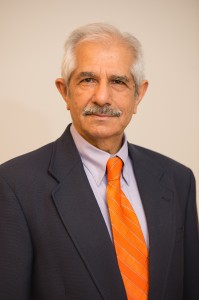 Location: Duncan Hall 1064, Rice University
Location: Duncan Hall 1064, Rice University
Date: January 30, 2015 – Time: 4:00 – 5:00 PM
With the advent of low-cost silicon solar panels and our ability to generate, store and use electrical energy locally without the need for long-range transmission, the world is about to witness transformational changes in electricity infrastructure. The use of PV as source of direct current (DC) power reduces the cost and improves the reliability of PV system. DC microgrid and DC nanogrid based on PV and battery storage can provide sustainable electric power to all human beings in equitable fashion. The electricity industry in developed economies is on the cusp of a dramatic transformation. Over 90 % of PV market share consists of non-concentrator bulk silicon solar cells. The maximum experimental efficiency of silicon solar cells is 25.6 % measured at standard conditions of AM 1.5 global spectrum. Although the observed efficiency of silicon solar cells is below the Shockley and Queisser (SQ) upper limit, marginal efficiency improvements are expected in future. For increasing the efficiency of single-junction cells beyond the Shockley–Queisser limit, several approaches based on concepts such as multiple exciton generation, carrier multiplication, hot-carrier extraction, etc., have been proposed; however, these are not commercially viable. Since both bulk-silicon and thin-film solar cells remain as the only two commercially viable options for terrestrial PV applications, a new device architecture appears promising for inexpensive PV electricity generation with efficiency exceeding the currently feasible 26% limit. The key objective of this talk is to highlight the specific research areas in device design, materials, processing and manufacturing of photovoltaic devices and systems that have further transformational capabilities of reducing power generated by PV systems.
Join us for this exciting session !! Learn more about Dr Singh and his research in here!
——————————————————————————————————–
The IEEE Photonics Houston Chapter was selected as the 2014 IPS Most Improved Chapter Award Winner!
Congratulations to Dr. Isabell Thomann, Shah Mohammad Bahauddin, Dr. Bujin Guo and John Maida for their chapter revitalization efforts!
Stay tuned for the next events!!!
——————————————————————————————————–
IEEE Photonics Houston welcomed Dr. Erik Garnett from FOM Institute AMOLF, Amsterdam !!
Talk Title: Solar Highways : Core-Shell Nanowires for High-efficiency Solar Conversion
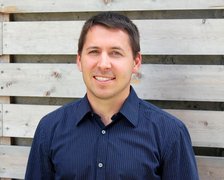 Location: Duncan Hall 1070 Rice University
Location: Duncan Hall 1070 Rice University
Date: May 6, 2014 – Time: 4:00 pm (Refreshments will be served at 3:45 pm)
The ideal solar cell fuel device would convert light into photogenerated carriers in an infinitely small volume. Such a structure not only limits material usage but also relaxes carrier diffusion length requirements and maximizes the output voltage. Here we describe a novel geometry consisting of a metal nanowire covered by an ultrathin semiconductor layer, which shows extreme light absorption enhancement. We present a theoretical model to explain why this structure works so well in both polarizations of light and use full-field simulations to demonstrate robust performance even with geometrical perturbations. We begin experimental work with a model system consisting of a silver nanowire core and cuprous oxide shell. These core-shell nanowires are synthesized at low temperature in solution and here we will present electron microscopy showing that they are single-crystalline with atomically sharp and coherent interfaces. Finally, we will present spatially-resolved, single nanowire optical measurements (reflection, scattering, absorption) taken using an integrating sphere and compare the results quantitatively to simulations. Our experiments suggest that this solar highways geometry should be explored further for photovoltaics and solar fuels applications.
Join us for this exciting session !! Learn more about Dr Garnett and his research in here!
IEEE Photonics Houston welcomed Prof. Dr. Deli Wang from UC San Diego !!
Talk Title: Engineering Semiconductor Nanowires for Light Sensing and Solar Fuel Application
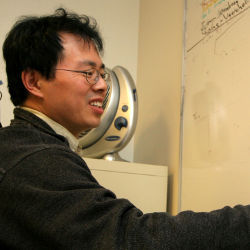 Location: Duncan Hall 1064 Rice University Date: April 23, 2014 – Time: 05:15 pm
Location: Duncan Hall 1064 Rice University Date: April 23, 2014 – Time: 05:15 pm
Abstract: “Nanomaterials (nanowire) by Design” allow well-controlled electrical and optical properties and enable enormous opportunities for applications in electronics, optoelectronics, biosensing, and renewable energy. In this talk, I will present our recent research efforts on the fabrication of 3D branched nanowire (b-NW) photoelectrodes for solar fuel generation. The 3D b-NW structure offers a unique pathway to integrate materials with different properties at nanoscale, and enables significant enhancement in device performance in energy harvesting, conversion, and storage. Particularly as photoelectrochemical electrodes, b-NWs offer enhanced light absorption, charge separation/transport, surface redox reaction rate and effective area, fast gas evolution at surface, all are critical to high efficiency solar fuel generation. Our efforts focus on using earth abundant materials (Si and metal oxides) and low cost fabrication, which offer a potential solution for practical and scalable solar fuel production. A second part of my talk will discuss high sensitivity nanowire photodetectors and the exploration of their potential application for retinal prosthesis. Specifically, I will present the fabrication of Si nanowire photodetectors and using them as artificial photoreceptors to stimulate ganglion neurons under light illumination.
Join us for this exciting session !! Learn more about Dr Wang and his research in here!
We have successfully arranged our first event and the event was applauded by the local research community and persons’ from industries. See the attach photos of the exciting event and keep eye on our website for more upcoming events !!
Distinguished Lecturer Dr. Simon Poole
Talk Title: Confessions of a Serial Entrepreneur: 30 years of Photonic start-ups in Academia and Industry
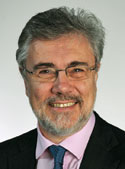 Location: Herzstein Hall 210, Rice University
Location: Herzstein Hall 210, Rice University
Date: December 9, 2013 – Time: 12:45 pm
Dr. Simon Poole, a distinguished innovator and entrepreneur will be sharing more than 30 years of experience in Photonics in a talk aimed to inspire researchers who are considering how to perfect their invention and commercialize their research into the growing industry. “Confessions of a Serial Entrepreneur : 30 Years of Photonic Start-ups in Academia and Industry“” will be an exciting session.
Join us for this exciting session !! Learn more about Dr Poole here!
I have no idea why I advertised the events below. Because I do not have the time to check the purpose of the event/information, it is hereby removed (August 18, 2017):
NRC wants the country to embark on a research program to fill its technological gaps in Photonics, and Optical Engineering
Eugene Arthurs, the CEO of SPIE said, “The time is now for the United States to make the right investments in the crucial capabilities of the future,” during the formation of a group to coordinate U.S. activities towards Photonic research. This Group of the National Photonics Initiative (NPI) includes the IEEE Photonics Society, the American Physical Society, the Laser Institute of America, the Optical Society, and SPIE, the International Society of Optics and Photonics. The group of societies also includes representatives from industry, academia, and government. The union issued a white paper, “Lighting the Path to a Competitive, Secure Future,” that outlined recommendations to guide funding and investment in five key fields: advanced manufacturing, communications and information technology, defense and national security, health and medicine, and energy. Read More here !
The IEEE Photonics Society annual meeting, formerly known as the IEEE LEOS Annual Meeting, was held at the Hyatt Regency Bellvue near Seattle, from September 8-12, and arranged four plenary sessions featuring invited talks on:
– Bio-Inspired Cameras
– Silicon Photonics for Lab-on-Chip and Point-of-Care Uses
– Microwave Quantum Optics in Superconducting Circuits
– Coherent optical transceivers
Seems interesting? Read More about the Exciting Event !


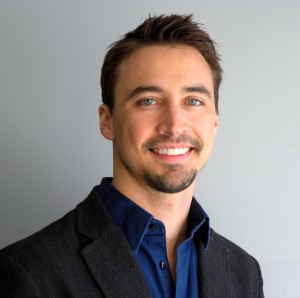
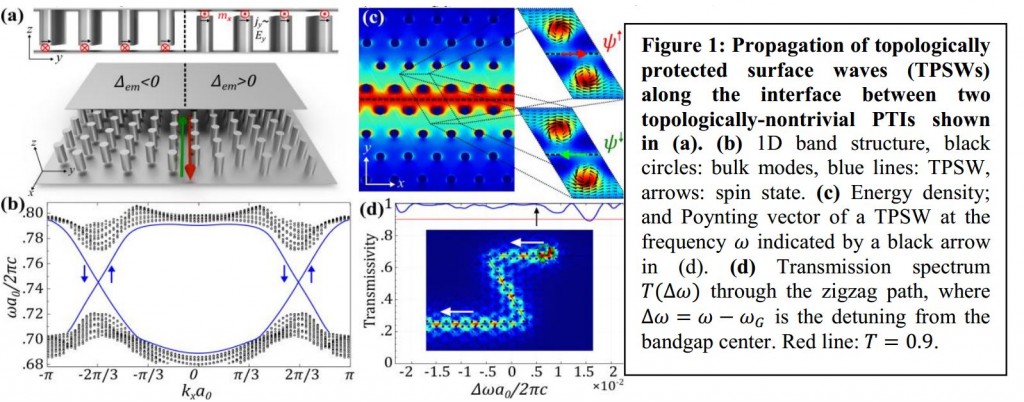
![WP_20150130_002[1]](http://ieeephotonics.rice.edu/files/2013/11/WP_20150130_0021-300x168.jpg)
![WP_20150130_001[1]](http://ieeephotonics.rice.edu/files/2013/11/WP_20150130_0011-300x168.jpg)
